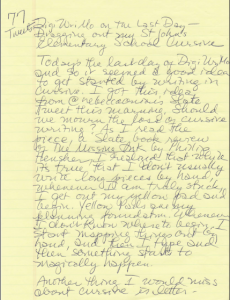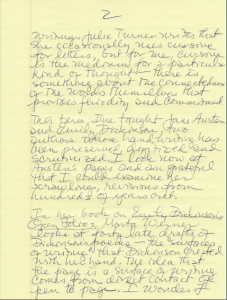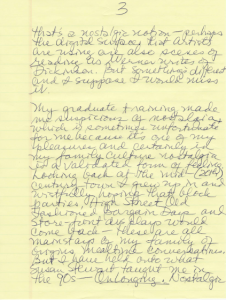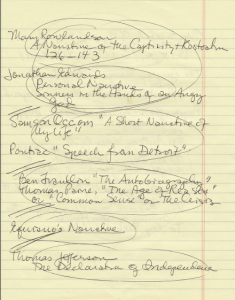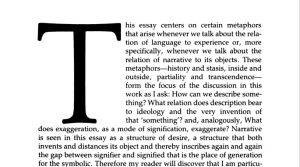
Preface to Susan Stewart’s _On Longing: Narratives of the Miniature, the Gigantic, the Souvenir and the Collection._ Duke UPress 2003.
Today I was inspired to reflect on cursive writing by a RT by @rebeccaonion on Julia Turner’s book review of Phillip Henscher’s book,The Missing Ink. I thought that since it’s the last digital do-day, officially, I would spend my discretionary writing time writing on yellow pads and scanning the pages in as pdf’s, thus appeasing Digi the Duck while also getting in touch with my Palmer method achievements.
So in sitting down to my yellow pad, many memories of my dissertation came back to me. To write myself out of Buffalo, New York, I was at my desk every morning at 8, and would write on yellow pads until lunch time. Then, after lunch, I woud type from the yellow pads until I had a draft, print out the draft, and spend the rest of the day editing those pages. So for me, the yellow pad has always represented the “source” material–the hardest writing in some ways, since it was always the new writing planned at the end of the previous day. The blank slate filled each day.The digital always came later, as the clean-up or the development crew. It’s “afternoon brain” work, rather than “morning brain” work.
As I was writing on yellow pads, I started thinking of the other writing I’ve always done on yellow pads, and one of those has been correspondence with a long-time mentor of mine, Taylor Stoehr, someone who has written against mediated experience for much of his life. So whenever I wrote him, no email would do. I would always put pen to paper.
So as I finished the 400 word (yes, Digi, that’s an estimate) yellow-pad document, I thought I’d scan my desk to see what other occasions have lent themselves to non-digital writing in the past weeks and I found two stray documents: one, some quotes and notes from my reading of Beloved for class, and the other the first draft of my reading list for my American Lit I syllabus.
Looking for commonalities among these cursive expressions, I realize that they are first forays. Different kinds of forays–into my thoughts on cursive, into the key passages of a novel I’m reading, into a new plan for a new class I’ve never read before. Do I ever hit “save draft” on a yellow pad? No–but there’s an assumption that it’s all being saved on the live-stream of words on the pad.
These are very drafty documents, and perhaps too tedious for an actual post. But I post them here because throughout the day –as I live tweeted a campus teaching conversation (#teaandtopics) I host, whose topic just happened to be digital literacy–I kept thinking about nostalgia and its pleasures, cursive writing and its pleasures and limitations. And I realized that while I love the place that handwriting has in my own life–from the nuns’ grudging approval of my cursive style in the 1960s to the yellow-pad letters to Taylor Stoehr–I am not worried about the next generation’s use of handwriting. Jane Austen showed us how essential a great hand was to her stories and how really opaque her own writing seems now to us. There is good reason to mark this moment when cursive goes the way of the residual in Raymond Williams’ terms; there is also great reason to celebrate the emergent.
So today, when one of my male Intro to Women Writer’s class students showed me his tubmlr feed in which he had assumed the identity of Jane Eyre who posts her life story through pictures complete with GPS data, I thought that however quaint my yellow pad is, with all it represents to me and means to me, this student is able to create something really fun and interesting and engaging–and doing so while honing skills that he needs more than I do. So I’m with Susan Stewart on this one, even as I cling to my yellow pages and the smooth, familiar surface of writing that I still create there.

